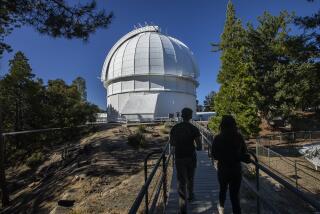New Telescope to Give Astronomers a Better View
- Share via
Standing in the shadow of the venerable Hooker telescope, which Edwin Hubble used to discover galaxies beyond our own Milky Way, dignitaries broke ground Saturday on a new telescope array that will be able to see a nickel at 10,000 miles.
The five-telescope array will spread spider-like across the San Gabriel mountains, sending columnated beams of light to a central “brain” that will combine them into an image 100 times sharper than the Hubble Space Telescope can produce.
“This is the next huge step forward in astrophysics,” said Carnegie Observatory astronomer Allan Sandage, who has been looking at the stars from Mt. Wilson for nearly half a century.
Ironically, the same thick layer of smog that blankets city dwellers below makes the skies above Mt. Wilson among the clearest astronomical sites in the world.
“Mt. Wilson is blessed by nature,” said Mt. Wilson Observatory Director Robert Jastrow. The mountain’s famous viewing conditions led Georgia State University--the new telescope’s sponsor--to choose the site over any other on the U.S. mainland.
“Astronomers have been coming to California for at least 100 years,” said Georgia State astronomer Brian Mason. “Mt. Wilson has the second-best seeing in the world.” (The best is Hawaii.)
But Georgia State University President Carl Patton also mentioned the long and illustrious history of the site, which has become hallowed ground for astronomers. It was at Mt. Wilson that the first galaxies beyond the Milky Way were discovered, as well as the expansion of the universe--a discovery that led to the Big Bang theory of creation.
The new $11.4-million array--called CHARA for Center for High Angular Resolution Astronomy--marks the second time this year that Mt. Wilson has stepped to the front of the line in astronomy since the Hooker was mothballed as obsolete by the Carnegie Institution in 1985.
Earlier this year, the Hooker got a new set of optics that allowed it to see sharper images than even the enormous Keck telescope in Hawaii. Most important for astronomers, the technique that allows CHARA to see so clearly paves the way for a new generation of telescopes that should be able to solve some fundamental cosmic questions--including the size and age of the universe. By combining the light from five separate light-gathering dishes, the telescope will be able to see as well as if it had a single huge light-gathering dish as big as the entire array--or about 500 yards in diameter.
Georgia State expects to have CHARA up and running by 1998.






